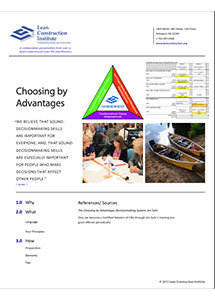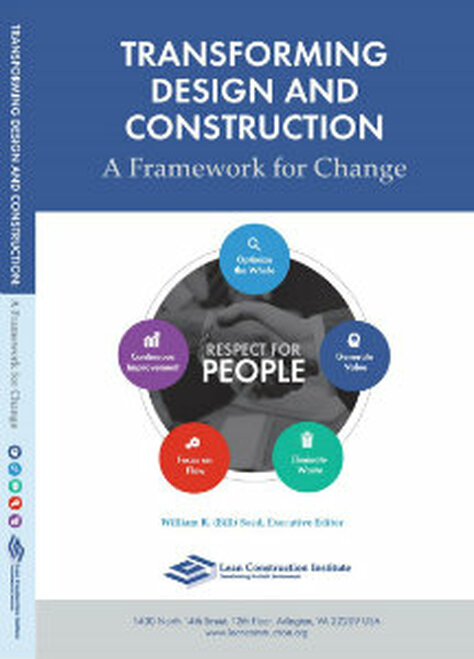Choosing By Advantages
Introduction to Choosing By Advantages (CBA)
The ability to make sound, well-reasoned decisions in a timely manner is crucial to any Lean project. The Choosing By Advantages (CBA) method is one way to make sound decisions. No project is ever executed perfectly to plan. Issues pop up frequently. The more equipped team members are to handle unexpected problems, the more likely they’ll be to make a decision that creates the most value.
Many decision making processes are flawed. They tend to be biased in a manner that aims to justify a predetermined desired outcome rather than allowing the best conclusion to be reached organically based on the relevant facts provided to those impacted by it.

Choosing By Advantages Meaning
Choosing By Advantages (CBA) is a tested and effective decision-making system developed by Jim Suhr in 1999 for determining the best decision by looking at the advantages of each option. CBA’s five phases of decision-making: stage-setting, innovation, decision-making, reconsideration, and implementation, which decreases waste while increasing efficiency, respect for team members, and project outcomes including profits.
CBA: A Decision Making Method
Choosing By Advantages (CBA) is a decision making method that helps team members make sound decisions in a group setting to ensure that the decision made yields the most value and leads to the best outcome for the stakeholders.
The CBA method acknowledges that all decisions are in the end subjective, but it helps team members use objective measures to inform those choices. The method is utilized when there are multiple variables that need to be considered to reach a sound decision. There may be many plausible decisions that could be made and CBA helps the team sort through them.
NOTE: Proficiency in CBA is required in order to use it; inexperienced use of CBA will likely result in poor decision-making.
Five Phases of CBA Decision Making
The Choosing By Advantages process includes five phases that guide the involved parties.
1. Stage-setting
Define the issue being discussed and what the ideal endpoint looks like. Define all of the known variables and facts that will inform the decision-making process. Note all of the individuals who will be impacted by the decision and ensure that they have a seat at the table for the decision-making process. All affected parties should have at least one representative accounted for.
2. Innovation
Formulate a range of alternatives (possible decisions) to be considered. Make sure your list is as comprehensive as possible; this is the list that the team will be working from when conducting the decision-making process. Ensure you are getting a full picture of possible alternatives from all members involved in the decision-making process. Determine the attributes of each alternative. What does each option present that the others do not? Do not worry about the importance of these attributes at this time, but be aware of what makes each possible decision different.
3. Decision-making
Weigh the alternatives that were selected. Decide the advantages that each one carries and summarize their attributes. Determine the importance of the advantages that each alternative carries. The alternative with the most importance of advantages should be the one that is selected, so it’s crucial that the importance of each advantage is weighed properly with the outcome in mind.
4. Reconsideration
Review the basis of the decision that was made. Does the decision seem like the best one to make given all of the facts known? If any member has doubts, allow them to express them before the decision is finalized. Any who are affected by the decision should have the opportunity to provide an opinion on the decision and how it may impact the outcome. Remember that the outcome is the most important factor in the decision-making process.
5. Implementation
With the outcome in mind, implement the decision made. Perform the PDCA (Plan, Do, Check, Adjust) of continuous improvement to determine how the decision performs in practice and how it can be improved upon in the future.
Benefits of CBA Decision Making
When multiple parties are involved in making a key decision or set of decisions in a project, it’s common for each party to become focused on what will most benefit their individual group. Choosing By Advantages allows the team to focus on the outcome, the needs of the stakeholder and their dedication to the Conditions of Satisfaction, which are ultimately the most important factors to consider when making decisions.
Collaboration
The collaborative nature of CBA thinking may also lead to previously unthought of solutions being uncovered once all angles and perspectives are considered. CBA thinking allows each party to see the problem from all perspectives, putting the decision makers into a frame of mind where complex decisions can be reached effectively.
Documentation
Additionally, utilizing CBA decision making allows project teams to physically document the decision-making process. The documentation can then be presented to the project owner, arming them with a thorough explanation of why the decision was reached and proving to them that the process was well thought-out.
Learning CBA
The Lean Construction Institute is committed to transforming the design and construction industry by providing Lean educational resources, conducting research, and facilitating local and national Lean events. Explore supplementary resources only made possible by LCI Corporate Members to further your understanding of the Choosing By Advantages process below.
Lean Assessments
How strong is your Lean knowledge? Take a Lean assessment to determine your current state so you have a baseline for improvement. Lean assessments are available for individuals, teams, and organizations alike. Whether you’re new to Lean or are an experienced Lean practitioner, Lean assessments are a great way to get started at LCI!
TAKE ASSESSMENTMore Lean Topics
From 5s to IPD, explore popular Lean design and construction topics below.















